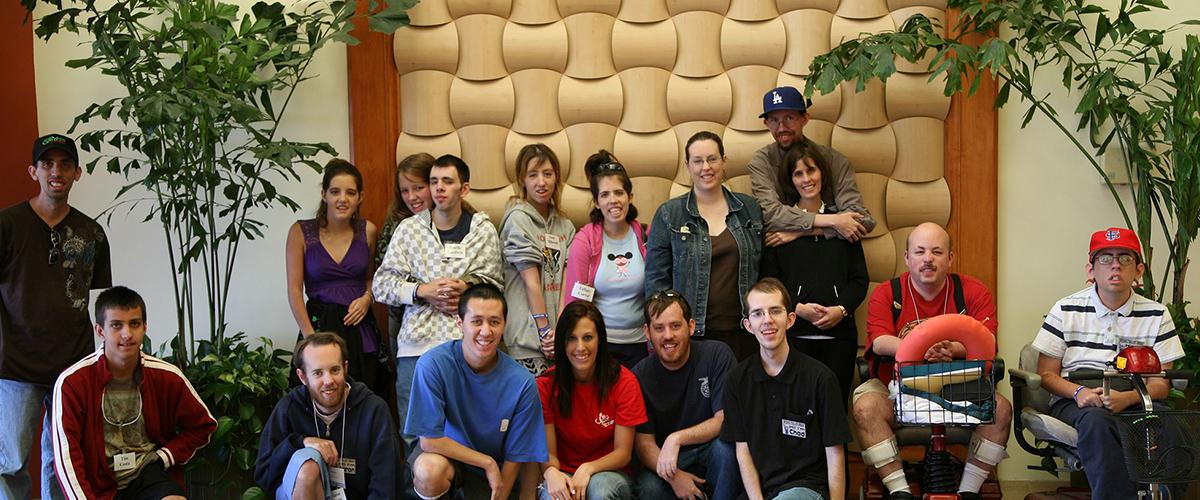Patterns:
-
Skeletal muscle weakness is not usually a major feature of childhood-onset DM1 but can be functionally limiting in those with CDM.
-
Children with CDM have delayed gross motor skills, but almost all obtain independent ambulation.
-
Children with CDM have improving motor function during the first few years of life, even those with profound hypotonia at birth. They benefit from promotion of motor function through therapy and other activities.
-
Myotonia can become problematic in late childhood or adolescence. Myotonia can contribute to muscle stiffness, pain, prolonged hand grip, speech and swallowing difficulties, and GI issues. Myotonia in DM1 is most prominent in the forearm and finger muscles, where it causes locking of the grip (“grip lock”). It sometimes affects tongue and jaw muscles, leading to difficulty with speech and chewing.
Symptoms:
-
Weakness and atrophy of the jaw and facial muscles has the greatest functional impact and results in a number of manifestations
-
Reduced facial expression.
-
Weakness of the facial, tongue and palatal muscles, leading to dysarthria, dysphagia, and jaw tightness.
-
Weakness of the eyelid muscles, leading to drooping of the eyelids (eyelid ptosis).
-
Orthopedic complications may occur in children with CDM. The most common complication is talipes equinovarus, though children may develop knee or hip contractures and scoliosi.
-
-
Delayed relaxation after grip or percussion, difficulty related to activities of daily life, progressive speech impairment, or profound irritable bowel symptoms.
Diagnosis:
-
Discuss the following tests with your doctor:
-
Grip myotonia can be observed by tightly gripping the clinician’s fingers, and then relaxing the hand after a sustained grip; the hand muscles will typically take 20 seconds or more to fully relax. Percussion myotonia can be demonstrated by a sustained contraction after the muscle is tapped with a reflex hammer. Electrical myotonia can also be demonstrated by abnormal, spontaneous muscle fiber discharges seen on a needle electromyogram (EMG).
-
Physical, occupational, and speech therapy needs early and often with specific attention to:
-
Feeding concerns and dysphagia.
-
Gross motor delay.
-
Gross and fine motor weakness.
-
Dysarthria and potential augmentative and alternative communication (AAC) needs.
-
Language acquisition delays.
-
-
Scoliosis; if necessary, consider bracing or referral to orthopedic surgeon.
-
Crowded teeth that benefit from orthodontic treatment. The goal of such treatment is to facilitate oral hygiene. Caregivers should be counseled to proactively maintain oral hygiene.
-
Treatment:
-
Surgical correction of talipes equinovarus or other contractures early in evaluation if these changes prevent appropriate biomechanical alignment for mobility, cause pain, or limit functional mobility.
-
Speech therapy targeting speech, language, and communication from a very early age.
-
Augmentative and alternative communication (AAC) therapy individualized for their linguistic and cognitive abilities if appropriate or necessary.
-
Newborns with CDM often have difficulty feeding and alternative nutrition should be considered/ After about a year of actively working with a speech therapist or OT, most children can generally start on PO feeding.
-
Children with CDM experience progressive improvement in their proximal strength until adolescence, at a minimum. Children should therefore be encouraged to participate in physical activity.
-
Assessment of joint arthokinematics and range of motion should be observed to manage development of joint contracture.
-
Prevention of joint contractures is key to management and should be closely monitored with early initiation of stretching.
-
Treatment of talipes equinovarus and other joint contractures should include initial stretching regiment and appropriate ankle bracing (for talipes equinovarus). Serial casting may be considered.
-
Drugs affecting ion channels, such as mexiletine (Mexitil), can improve myotonia, although their potential for causing cardiac arrhythmias must be weighed against their possible benefits.

